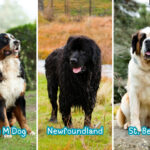 3 Nov
3 Nov8 Must Know Facts About Golden Retrievers
As a seasoned dog parent and avid writer on all things canine, I find Golden Retrievers to be among the most fascinating and rewarding companions out there. Whether you’re considering adding one of these golden-hearted pups to your family or you’re simply keen to learn more about them, you’ve come to the right place.
Understanding these eight must-know facts about Golden Retrievers will not only deepen your appreciation for the breed but also equip you with the knowledge to care for them better. And if you’re already the proud owner of one of these affable dogs, these insights will help you provide the best home possible. So let’s get right to it and explore what makes Golden Retrievers such exceptional pets and friends.

Fact #1. The Origin of Golden Retrievers
Golden Retrievers have a rich and fascinating history that dates back to the 19th century in Scotland. Developed by Lord Tweedmouth, whose real name was Dudley Marjoribanks, these dogs were bred with a clear and purposeful design in the highlands of Scotland. The narrative of their origin is one of practicality and innovation.
The breeding program began with ‘Nous,’ a yellow Wavy-Coated Retriever, and ‘Belle,’ a Tweed Water Spaniel—a breed that is now unfortunately extinct. Lord Tweedmouth aimed to create a breed that was adept at retrieving game on land and in water, given the rainy climate and rugged terrain of his estate.
This was a time when hunting was not just a sport but a means of gathering food, and thus, the practicality of the dog’s abilities was paramount. Through meticulous selection and breeding, which also included infusions of the Irish Setter, Bloodhound, and more Tweed Water Spaniels, the foundation was laid for what we now know as the Golden Retriever. Over time, these dogs were recognized for their excellent retrieval skills, gentle mouths, and loyal dispositions.
The Purpose Behind the Breed’s Creation
The creation of the Golden Retriever was motivated by the demand for a superior gundog suited for the Scottish landscape and the hunting style of the time. Retrieving the game was an essential task, and the ideal dog needed to have a soft mouth to retrieve shot game undamaged, a love for water, and an obedient nature to follow the hunters’ commands.
Lord Tweedmouth’s breeding program was aimed at achieving these characteristics. The resulting Golden Retrievers were not only efficient workers but also displayed a high level of intelligence and a gentle temperament, which made them excellent for the task at hand. Moreover, their water-repellent double coat protected them against harsh Scottish weather conditions.
The breed was officially recognized by The Kennel Club of England in 1911 as ‘Retriever — Yellow or Golden,’ and later, the name was officially changed to Golden Retriever in 1920. Since then, the breed’s popularity has only grown, not just as hunting companions but as family pets, guide dogs, and in various service roles, embodying the versatility that was ingrained in their origin.
Fact #2. Physical Characteristics
Description of Their Distinctive Coat and Color
One of the most striking features of Golden Retrievers is their beautiful, dense coat. Known for its water-repellency, the coat comes in various shades of gold, giving the breed its name. The range can vary from a light, creamy color to a rich, golden hue, and sometimes even a darker copper. Some Golden Retrievers may have a few white hairs interspersed, particularly on the chest, but the breed standard generally favors the solid gold tones.
This lustrous double coat consists of a softer undercoat that provides insulation and a sturdier topcoat that helps to repel water and dirt. Seasonal shedding is a common trait, with a heavier shed typically occurring once or twice a year, known colloquially as “blowing their coat.” Regular grooming is essential for maintaining the health and appearance of their coat, which can be wavy or straight, but always full and feathered.
Average Size and Weight
Golden Retrievers are classified as a large breed, exhibiting strength and elegance in their build. Males typically stand between 23 to 24 inches tall at the withers (the highest point of the shoulder blades), while females are slightly smaller, ranging from 21.5 to 22.5 inches. When it comes to weight, a healthy male can weigh between 65 to 75 pounds, whereas females generally weigh between 55 to 65 pounds.
These dogs are known for their well-balanced and symmetrical form, displaying neither cloudiness nor weakness in their build. They possess a level top line and a broad head with a straight muzzle and clear, friendly eyes. Their overall body shape should suggest power and agility, characteristics essential to their historical work as retrievers.
A prospective owner should be aware that maintaining a healthy weight is crucial for Golden Retrievers. Their love for food and their tendency to put on weight easily necessitate proper diet control and regular exercise to avoid issues such as obesity, which can lead to more severe health problems.
Fact #3. Temperament and Personality Traits
Their Reputation for Friendliness and Patience
Golden Retrievers are the epitome of friendliness and patience, traits that have endeared them to countless dog enthusiasts worldwide. Known for their amiable and accommodating nature, these dogs exude a joyful demeanor that is both infectious and heartwarming. They approach life with a cheerful disposition and an eagerness to please, making them a perennial favorite among pet owners.
Their patience is especially notable, allowing them to tolerate a range of situations and environments with a calm composure. This patience, combined with an inherent kindness, makes them excellent companions for individuals of all ages and lifestyles. Whether they’re waiting for their turn to play fetch or calmly sitting by while family members go about their daily routines, Golden Retrievers typically display a gentle forbearance that is a hallmark of the breed.

Suitability for Families and Children
Golden Retrievers are often touted as the ideal family pet, and for good reason. Their stable and loving temperament makes them wonderful companions for children. They are known to be exceptionally gentle and vigilant when interacting with kids, often displaying an intuitive sense of the fragility of young family members. This makes them trustworthy companions for playtime in the yard, as well as cozy snuggle buddies during quieter moments.
Furthermore, Golden Retrievers tend to be very sociable, enjoying the company of people and thriving in a family environment where interaction and activities are abundant. Their adaptability allows them to fit into various family dynamics, from being an active participant in outdoor adventures to being a calm presence in a more subdued household.
It’s important to note, however, that like all dogs, Golden Retrievers require proper socialization and training to ensure that their interactions with children and adults remain positive and safe. Their innate desire to be part of the family pack makes them responsive to training and eager to follow household rules.
With their blend of loyalty, affection, and playfulness, Golden Retrievers not only enrich the lives of their human counterparts but also teach valuable lessons in compassion and camaraderie. This makes them more than just pets; they become integral and beloved members of the family.
Fact #4. Training and Intelligence
Golden Retrievers’ Intelligence Ranking
Golden Retrievers are often celebrated for their high level of intelligence, consistently ranking near the top of recognized lists for smartest dog breeds. According to renowned canine psychologist Dr. Stanley Coren, Golden Retrievers stand at the fourth position in terms of obedience-command trainability.
This intelligence manifests in their ability to learn new commands quickly, often understanding new instructions with fewer than five repetitions and obeying a command on the first attempt with a success rate of 95% or better.
Their intellectual prowess is complemented by an eagerness to engage and a pleasure in performing tasks, which makes the training process not only successful but also an enjoyable bonding experience for the dog and the owner. This cognitive capacity enables them to excel in problem-solving activities and makes them apt pupils in various training contexts.
Trainability and Common Uses in Services and Roles
The trainability of Golden Retrievers is one of their most celebrated traits. They are incredibly versatile and can be trained for a wide array of roles beyond the basic family pet.
Their keen intelligence, coupled with a strong desire to please, makes them outstanding candidates for service work. Golden Retrievers are commonly trained as guide dogs for the blind, hearing dogs for the deaf, and search-and-rescue dogs due to their strong sense of smell and innate ability to adapt to challenging situations.
They also frequently participate in therapy dog programs, offering comfort and affection in hospitals, schools, and nursing homes. Their gentle nature and intuitive sensitivity to human emotions make them perfect for such emotionally supportive roles.
In more active service capacities, Golden Retrievers have been trained for law enforcement roles, including drug and bomb detection, due to their concentration and persistence. Their athleticism and love for activity are channeled effectively in agility and obedience competitions as well, where they often secure top honors.
Training a Golden Retriever requires consistency, positivity, and reinforcement techniques that reward their progress. However, their intelligence means they can sometimes be too smart for their own good, picking up on bad habits just as quickly as good ones if not guided appropriately. Thus, training should begin early, focusing on socialization and basic commands, and evolving into more complex tasks as the dog matures.
Fact #5. Exercise and Activity Needs
Daily Exercise Requirements
Golden Retrievers are energetic and active dogs that require regular exercise to maintain their physical health and happiness. As a breed with a history of sporting and working, they possess a good deal of stamina and benefit greatly from daily physical activity. It is generally recommended that they receive at least one hour of exercise per day, but some may need more, especially younger dogs or those with higher energy levels.
This exercise can come in various forms, from brisk walks to jogging, and should ideally be complemented with periods of off-leash play in a secure environment. Activities such as fetch, swimming, and hiking are not only great ways to burn energy but also offer sensory-rich experiences that Golden Retrievers find fulfilling. Engaging them in these kinds of activities helps prevent the development of undesirable behaviors that can stem from boredom or excess energy.
Mental Stimulation and Activity Ideas
Golden Retrievers don’t just need physical exercise; they also require mental stimulation to keep their minds sharp and engaged. Mental exercise can often tire a dog just as effectively as physical activity, and it’s vital for preventing cognitive decline as they age.
Puzzle toys and treat-dispensing games are excellent tools for mental exercise, challenging their problem-solving skills and rewarding their efforts. Training sessions, which can include learning new tricks or practicing obedience skills, also serve as a great form of mental stimulation. Moreover, Golden Retrievers often excel in dog sports such as agility, flyball, and competitive obedience, which can provide both physical and mental challenges.
Incorporating scent work or tracking games into their routine can capitalize on their natural abilities and offer intense mental workouts. Even simple activities like hiding treats around the house or creating obstacle courses can provide valuable mental enrichment.
Balancing physical exercise with mental stimulation will not only keep a Golden Retriever’s body fit but also ensure their mind remains active and engaged. Owners who invest time in meeting both these needs are rewarded with a well-rounded, content, and happy companion.

Facts #6. Health and Lifespan
Common Health Issues Faced by the Breed
Golden Retrievers are generally healthy dogs, but like all breeds, they are prone to certain health conditions. Being aware of these common issues can help owners and prospective owners prepare and provide the best care possible.
One of the more significant health concerns in Golden Retrievers is hip and elbow dysplasia, a hereditary condition that can lead to arthritis and lameness. Eye conditions such as cataracts, progressive retinal atrophy, and glaucoma also appear with some frequency in the breed. Additionally, they may be susceptible to certain heart diseases like subvalvular aortic stenosis.
Golden Retrievers have a higher incidence of cancer compared to many other breeds, with hemangiosarcoma, lymphosarcoma, mast cell tumors, and osteosarcoma being particularly common. It’s essential for regular veterinary check-ups to include wellness screenings for early detection of these diseases.
Skin conditions, including allergies and hot spots, can also be an issue, often exacerbated by their dense coat if not properly groomed and maintained.
Tips for Maintaining a Healthy Lifestyle and Prolonging Lifespan
To help ensure a healthy life for a Golden Retriever, consider the following tips:
- Regular Exercise: Maintain a regular exercise routine to help prevent obesity, which can contribute to joint problems and other health issues.
- Balanced Diet: Feed them a balanced diet appropriate for their age, size, and activity level. Avoid overfeeding and provide a diet with the necessary nutrients to support joint health and a robust immune system.
- Routine Veterinary Care: Keep up with regular veterinary check-ups. Preventive care can detect health problems early, improving the chances of successful treatment and management.
- Mental Health: Mental stimulation is as important as physical health. Keep their mind active with training and problem-solving activities.
- Dental Hygiene: Oral health can affect overall health. Brush their teeth regularly and provide dental chews to help prevent gum disease and tooth decay.
- Grooming: Regular grooming helps prevent skin issues and allows for the early detection of any unusual signs or lumps on the skin.
- Genetic Screening: Before breeding, responsible breeders should perform genetic screening to reduce the incidence of hereditary conditions in offspring.
- Avoiding Environmental Toxins: Minimize exposure to pesticides and toxic household substances that can contribute to health issues.
By following these guidelines, owners can contribute positively to their Golden Retrievers’ overall well-being, potentially extending their lifespan. Golden Retrievers typically enjoy a lifespan of around 10 to 12 years, and with proper care, they can spend these years as a healthy and joyful companion.
Fact #7. Grooming and Care
Grooming Needs: Shedding Patterns and Coat Care
Golden Retrievers are as famous for their beautiful, shiny coats as they are for leaving said coats all over your home. They shed moderately throughout the year and more heavily during the spring and fall when they “blow” their undercoats. During these times, more frequent brushing is necessary, sometimes even daily, to keep the loose fur under control and ensure their skin and coat remain healthy.
Regular grooming should include:
- Brushing: Using a slicker brush several times a week will help to remove tangles and loose hair, distribute natural oils, and prevent matting, especially in the denser undercoat.
- Bathing: They don’t require frequent baths, but a monthly wash can keep their coat clean and looking its best. It’s important to use a dog-specific shampoo to maintain the coat’s natural oils.
- Ear Care: Their floppy ears can trap moisture and debris, leading to infections. Regular cleaning and checking are vital.
- Nail Trimming: Active dogs wear down their nails naturally, but regular trims might be necessary to prevent splitting or cracking.
- Paw Care: Check their paws regularly for any debris or injuries, especially after walks or outdoor play.
Dietary Considerations and Nutrition
Proper nutrition is a cornerstone of a Golden Retriever’s health and longevity. Here are some considerations for feeding your Golden:
- Balanced Diet: They require a well-balanced diet that is age-appropriate. Puppies, adults, and senior dogs have different nutritional needs. High-quality dog food that provides a good balance of protein, fat, and carbohydrates is essential.
- Portion Control: Golden Retrievers love to eat and can easily become overweight. Controlling their portion sizes and not giving in to those pleading eyes for extra treats is important.
- Regular Meal Times: Consistent feeding times help prevent digestive problems. Typically, two meals a day is a good routine.
- Healthy Treats: Opt for healthy treats, especially during training, to avoid unnecessary weight gain.
- Clean Water: Always provide access to fresh, clean water to stay hydrated.
- Special Diets: Some Goldens may have specific dietary needs or food sensitivities. It’s crucial to work with your vet to determine the best food for your dog, especially if they show signs of allergies or gastrointestinal issues.
Proper grooming and attention to diet will not only keep your Golden Retriever looking great but feeling great too. As always, it’s best to consult with a veterinarian for personalized care advice tailored to your dog’s unique health needs.

Fact #8. Golden Retrievers in Popular Culture
Famous Golden Retrievers in Movies and Media
Golden Retrievers have graced both big and small screens with their presence, often epitomizing the ideal family dog. One of the most memorable roles is that of “Shadow” in the family-friendly adventure film “Homeward Bound: The Incredible Journey,” where the Golden Retriever character showcases loyalty and perseverance. Another iconic Golden is “Buddy,” who starred in the original “Air Bud” movie, demonstrating not only the breed’s intelligence but also their athletic prowess.
In television, the Golden Retriever “Comet” from the beloved sitcom “Full House” further solidified the breed’s reputation as the quintessential family pet. These appearances have been instrumental in cementing the Golden Retriever’s status as a gentle and devoted companion in the minds of audiences around the world.
Influence on Popular Perception of the Breed
The frequent casting of Golden Retrievers in heartwarming and family-oriented roles has had a significant influence on the popular perception of the breed. Their on-screen persona as loving, patient, and family-friendly dogs reflects their real-life characteristics and has contributed to their popularity.
This media portrayal has undoubtedly played a role in making the Golden Retriever one of the most desired breeds, often seen as the perfect pet for a household with children. It has also set a certain expectation for their behavior, which is generally positive, but it’s crucial for potential owners to understand that, like all dogs, Golden Retrievers have individual personalities and require training, socialization, and proper care.
While their on-screen image often highlights the breed’s best traits, it’s important to remember that each Golden Retriever is unique. The ones we see in movies and on television are often trained professionals, and while many Goldens are indeed wonderful family dogs, they still come with all the responsibilities of canine care and training to ensure they are well-adjusted members of the family.
Their portrayal in the media can serve as a fantastic introduction to the breed’s potential, but it’s the shared experiences between real-life Goldens and their owners that truly define what it means to have one of these magnificent dogs as a part of the family.




